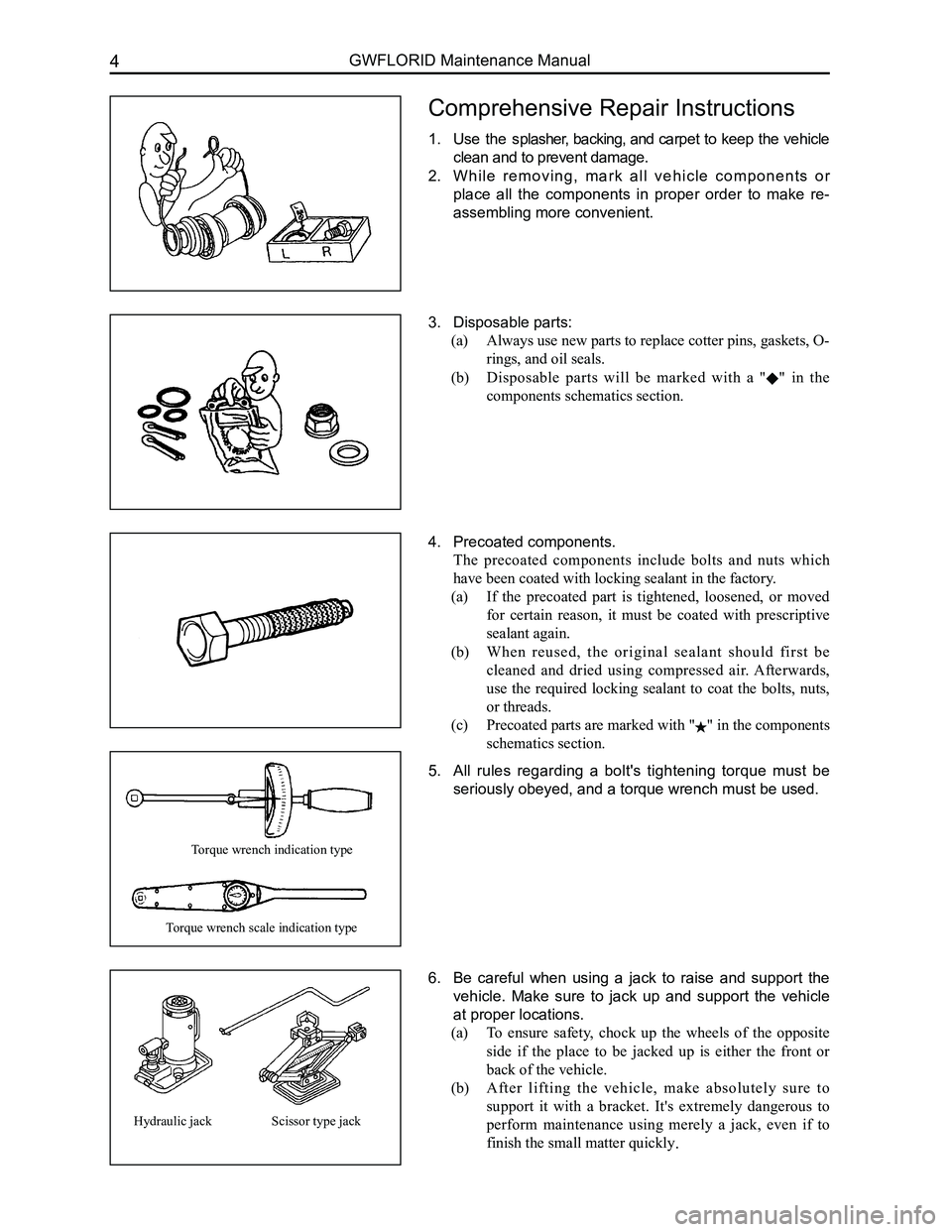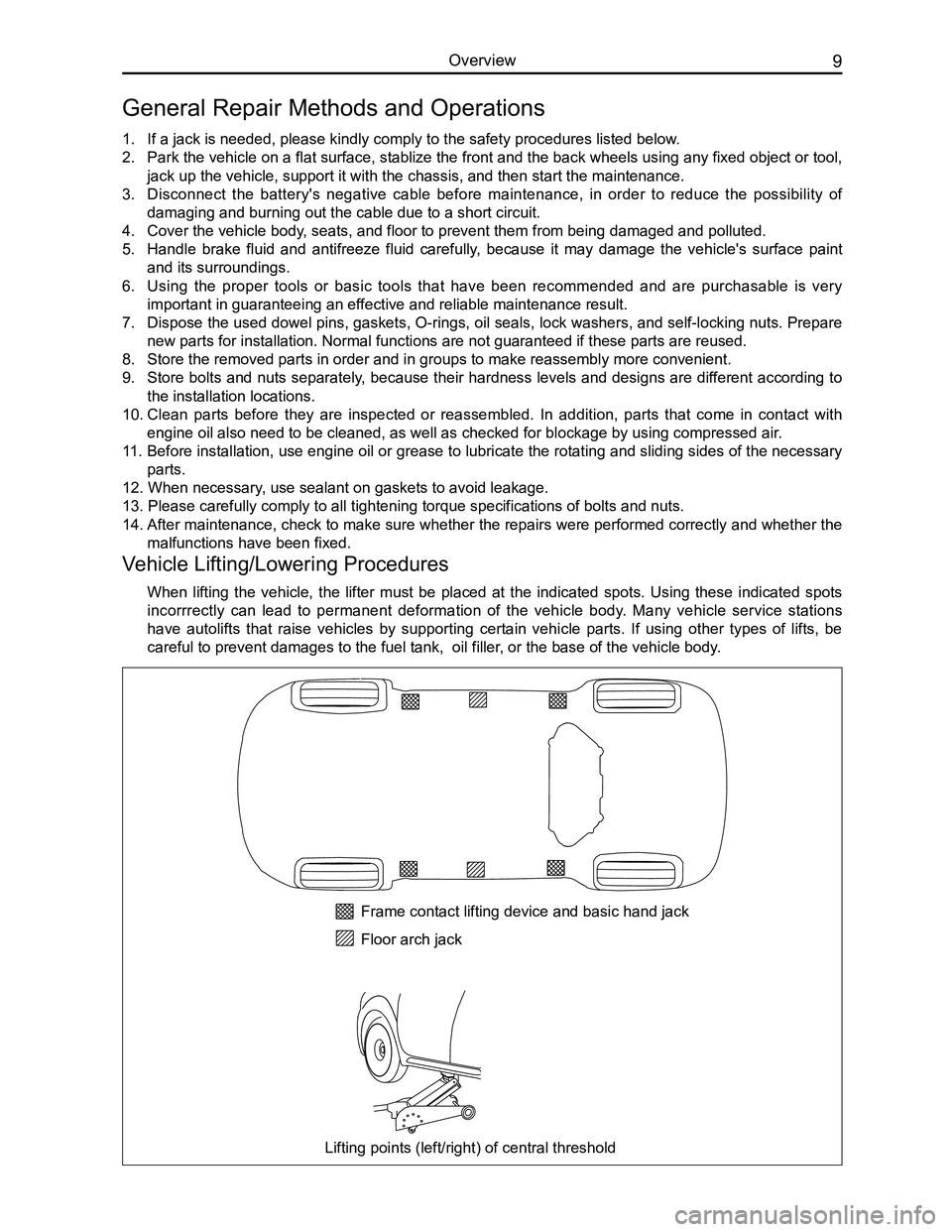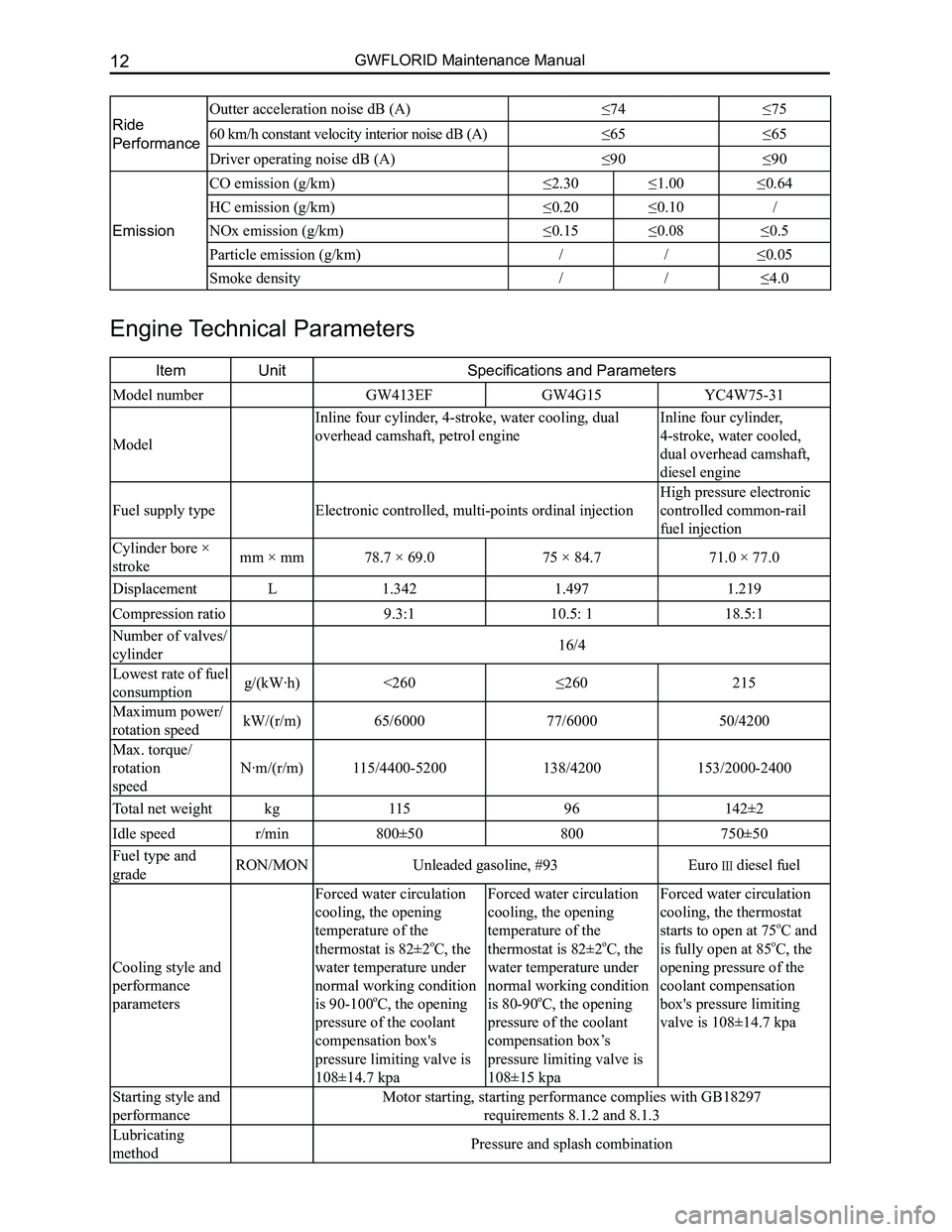gas type GREAT WALL FLORID 2008 Service Manual
[x] Cancel search | Manufacturer: GREAT WALL, Model Year: 2008, Model line: FLORID, Model: GREAT WALL FLORID 2008Pages: 281, PDF Size: 43.97 MB
Page 11 of 281

Downloaded from www.Manualslib.com manuals search engine GWFLORID Maintenance Manual4
Comprehensive Repair Instructions
1. Use the splasher, backing, and carpet to keep the vehicle
clean and to prevent damage.
2. W h i l e r e m o v i n g , m a r k a l l v e h i c l e c o m p o n e n t s o r
place all the components in proper order to make re-
assembling more convenient.
3. Disposable parts:
(a) Always use new parts to replace cotter pins, gaskets, O-
rings, and oil seals.
(b) Disposable parts will be marked with a "" in the
components schematics section.
4. Precoated components.
The precoated components include bolts and nuts which
have been coated with locking sealant in the factory.
(a) If the precoated part is tightened, loosened, or moved
for certain reason, it must be coated with prescriptive
sealant again.
(b) When reused, the original sealant should first be
cleaned and dried using compressed air. Afterwards,
use the required locking sealant to coat the bolts, nuts,
or threads.
(c) Precoated parts are marked with "" in the components
schematics section.
5. All rules regarding a bolt's tightening torque must be
seriously obeyed, and a torque wrench must be used.
6. Be careful when using a jack to raise and support the
vehicle. Make sure to jack up and support the vehicle
at proper locations.
(a) To ensure safety, chock up the wheels of the opposite
side if the place to be jacked up is either the front or
back of the vehicle.
(b) After lifting the vehicle, make absolutely sure to
support it with a bracket. It's extremely dangerous to
perform maintenance using merely a jack, even if to
finish the small matter quickly.
Torque wrench indication type
Torque wrench scale indication type
Hydraulic jackScissor type jack
Page 16 of 281

Downloaded from www.Manualslib.com manuals search engine 9Overview
General Repair Methods and Operations
1. If a jack is needed, please kindly comply to the safety procedures liste\
d below.
2. Park the vehicle on a flat surface, stablize the front and the back wheels using any fixed object or tool,
jack up the vehicle, support it with the chassis, and then start the mai\
ntenance.
3. Disconnect the battery's negative cable before maintenance, in order to reduce the possibility of
damaging and burning out the cable due to a short circuit.
4. Cover the vehicle body, seats, and floor to prevent them from being damaged and polluted.
5. Handle brake fluid and antifreeze fluid carefully, because it may damage the vehicle's surface paint
and its surroundings.
6. Using the proper tools or basic tools that have been recommended and are purchasable is very
important in guaranteeing an effective and reliable maintenance result.
7. Dispose the used dowel pins, gaskets, O-rings, oil seals, lock washers, and self-locking nuts. Prepare
new parts for installation. Normal functions are not guaranteed if these\
parts are reused.
8. Store the removed parts in order and in groups to make reassembly more c\
onvenient.
9. Store bolts and nuts separately, because their hardness levels and designs are different according to
the installation locations.
10. Clean parts before they are inspected or reassembled. In addition, parts that come in contact with
engine oil also need to be cleaned, as well as checked for blockage by u\
sing compressed air.
11. Before installation, use engine oil or grease to lubricate the rotating and sliding sides of the necessary
parts.
12. When necessary, use sealant on gaskets to avoid leakage.
13. Please carefully comply to all tightening torque specifications of b\
olts and nuts.
14. After maintenance, check to make sure whether the repairs were performed correctly and whether the
malfunctions have been fixed.
Vehicle Lifting/Lowering Procedures
When lifting the vehicle, the lifter must be placed at the indicated spots. Using these indicated spots
incorrrectly can lead to permanent deformation of the vehicle body. Many vehicle service stations
have autolifts that raise vehicles by supporting certain vehicle parts. If using other types of lifts, be
careful to prevent damages to the fuel tank, oil filler, or the base of the vehicle body.
Frame contact lifting device and basic hand jack
Floor arch jack
Lifting points (left/right) of central threshold
Page 19 of 281

Downloaded from www.Manualslib.com manuals search engine GWFLORID Maintenance Manual12
Ride
Performance
Outter acceleration noise dB (A)≤74≤75
60 km/h constant velocity interior noise dB (A)≤65≤65
Driver operating noise dB (A)≤90≤90
Emission
CO emission (g/km)≤2.30≤1.00≤0.64
HC emission (g/km)≤0.20≤0.10/
NOx emission (g/km)≤0.15≤0.08≤0.5
Particle emission (g/km)//≤0.05
Smoke density//≤4.0
Engine Technical Parameters
ItemUnitSpecifications and Parameters
Model numberGW413EFGW4G15YC4W75-31
Model
Inline four cylinder, 4-stroke, water cooling, dual
overhead camshaft, petrol engine
Inline four cylinder,
4-stroke, water cooled,
dual overhead camshaft,
diesel engine
Fuel supply typeElectronic controlled, multi-points ordinal injection
High pressure electronic
controlled common-rail
fuel injection
Cylinder bore ×
strokemm × mm78.7 × 69.075 × 84.771.0 × 77.0
DisplacementL1.3421.4971.219
Compression ratio9.3:110.5: 118.5:1
Number of valves/
cylinder16/4
Lowest rate of fuel
consumption g/(kW·h)<260≤260215
Maximum power/
rotation speed kW/(r/m)65/600077/600050/4200
Max. torque/
rotation
speed
N·m/(r/m)115/4400-5200138/4200153/2000-2400
Total net weightkg11596142±2
Idle speedr/min800±50800750±50
Fuel type and
gradeRON/MONUnleaded gasoline, #93Euro diesel fuel
Cooling style and
performance
parameters
Forced water circulation
cooling, the opening
temperature of the
thermostat is 82±2oC, the
water temperature under
normal working condition
is 90-100oC, the opening
pressure of the coolant
compensation box's
pressure limiting valve is
108±14.7 kpa
Forced water circulation
cooling, the opening
temperature of the
thermostat is 82±2oC, the
water temperature under
normal working condition
is 80-90oC, the opening
pressure of the coolant
compensation box’s
pressure limiting valve is
108±15 kpa
Forced water circulation
cooling, the thermostat
starts to open at 75oC and
is fully open at 85oC, the
opening pressure of the
coolant compensation
box's pressure limiting
valve is 108±14.7 kpa
Starting style and
performance
Motor starting, starting performance complies with GB18297
requirements 8.1.2 and 8.1.3
Lubricating
methodPressure and splash combination